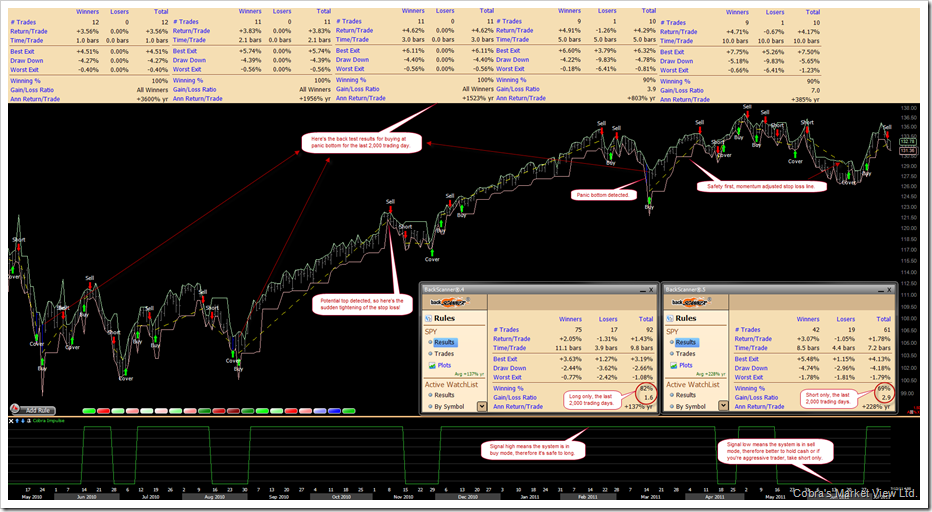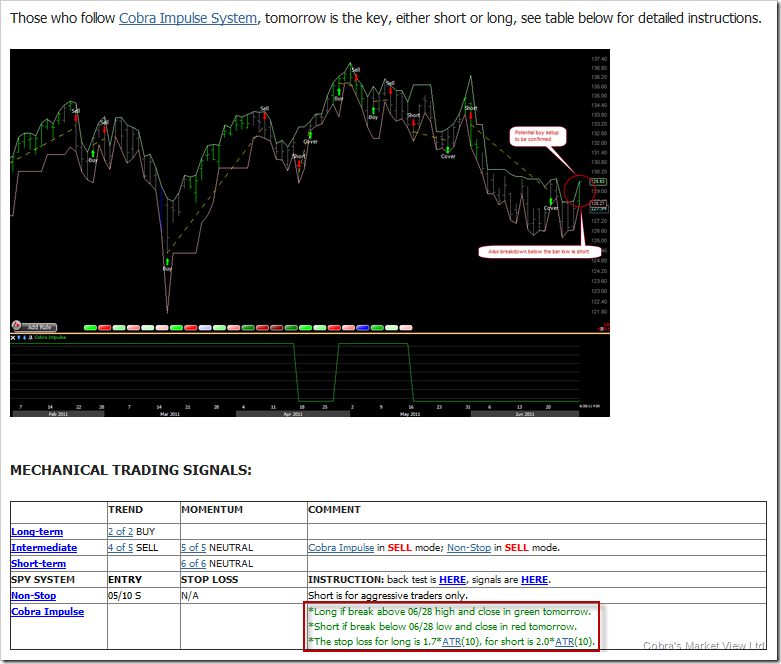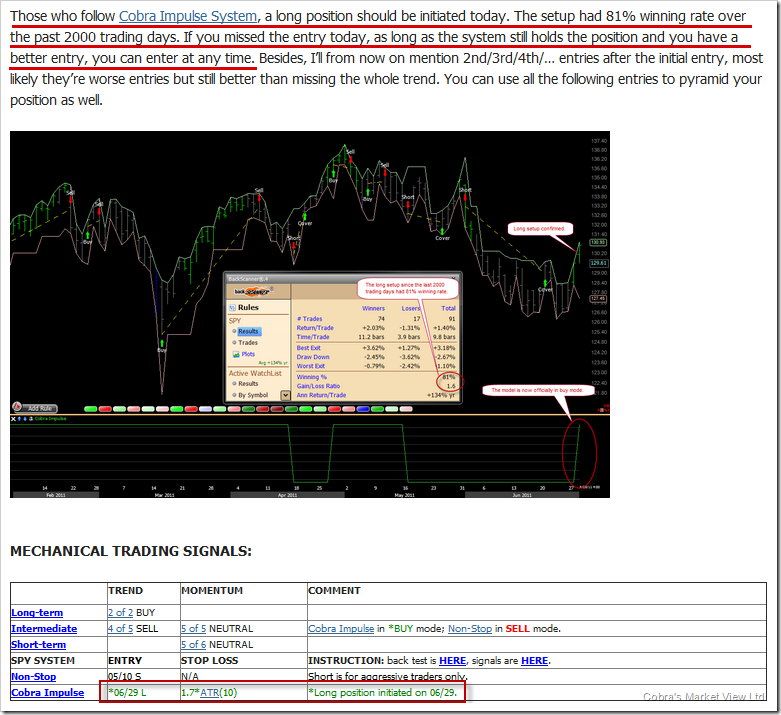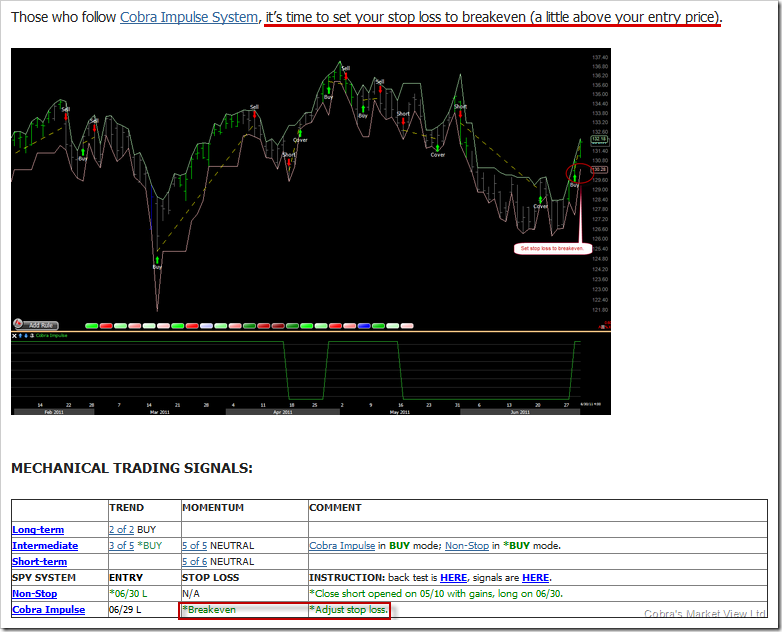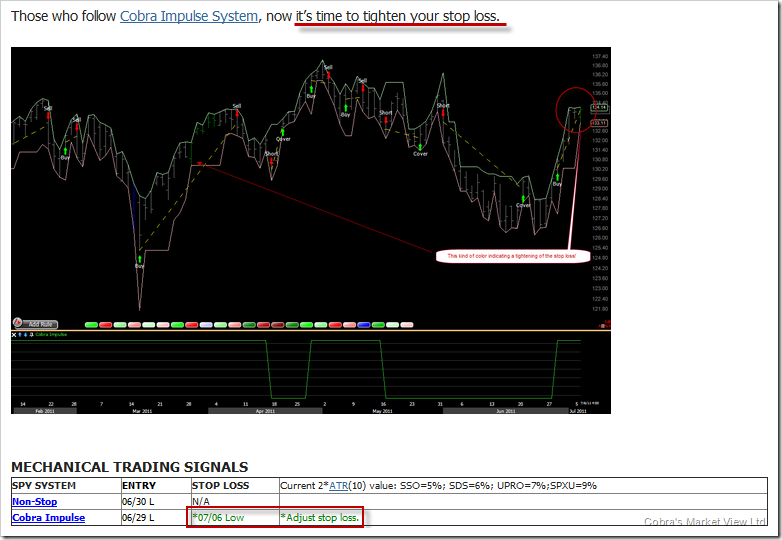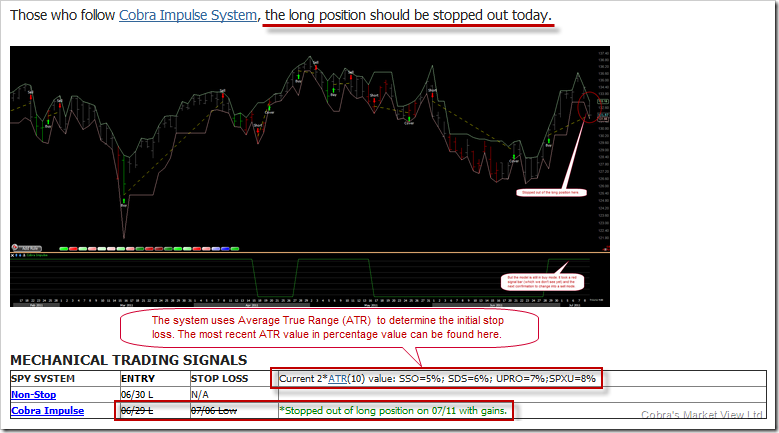Cobra Impulse System serves 2 major purposes for my market report:
It’s my official intermediate trend signal.
If you find very hard to understand what I blah blah every day, here’s a simple rule:
- Try your best not to trade against the system. When the system is in buy mode, you long only while the system is in sell mode, you either in cash or more aggressively short only.
So how to know whether the system is in buy mode or sell mode?
- It’s in the Summary of Signals table at the end of my daily market outlook. See chart below.
It provides trading signals for SPY and its related leveraged funds, such as SSO, SDS, UPRO and SPXU.
The system is back tested since year 1991 (Last 5,000 trading days) to at least make sure it worked perfectly in the past. Of course, working in the past doesn’t guarantee it’d work for the future but at least it proves theoretically it should work. The chart below shows the back test summary for the last 2,000 trading days as well as some unique features of the system. The approximate annual return could be calculated as: 92 * 1.43% / 2000 * 260 = 17.10% for long only plus 61 * 1.78% / 2000 * 260 = 14.12%, so 17% + 14%, around 31% annual return for SPY only and if you use leveraged fund, the return should be much higher which I think is not bad.
So where to find the trading signals? It’s in my daily trading signals report. See examples below:
- The day before the signal could be triggered, I give detailed instructions in the day’s trading signals.
- When the signal is confirmed, I acknowledge the position in the day’s trading signals.
- Then I keep notifying you when the stop loss needs to be adjusted to protect gains, also in the day’s trading signals.
- Finally when the position is stopped out, I acknowledge it again in the day’s trading signals.
- The system uses ATR to determine the initial stop loss value. The most recent ATR value in percentage value can also be found in the day’s trading signals, see image above. Say, in the signals table, I give 2*ATR(10) value in percentage, for example, today's value, SSO = 11%, so say, tomorrow you bought SSO at 40.30, so the stop loss would be, assume you use 2*ATR(10), 40.30 - 40.30 * 11% = 35.87. If you want to use, say 1.7*ATR(10), since the table says 2*ATR(10) is 11%, so 11% / 2 * 1.7 = 9.35% = 10%, you can use 10% as your stop loss. If you find hard to understand how I get 1.7*ATR(10), you can just use the value I give in the table which is 2*ATR(10), right now at 11%. Each day the value maybe different, you just use that day's value, no more changes needed thereafter.
- Please make sure you read How Many Shares to Buy to get the very basic idea of the position sizing. The rule I’m using is to risk no more than 2% of my total capital, so say, I have $100,000, 2% * $100,000 would be $2,000, the stop loss for SSO as mentioned above for now is 5%, so $2,000 / 5% = $40,000, the SSO current price is $50, so $40,000 / $50 = 800 which is the max number of shares I can buy for each trade.
- The system is designed to stay in the trend as long as possible, so it uses only stop loss to get out the position which inevitably sometimes would result in losing significant portion of the profits so you have to take partial profits whenever you see appropriate.
- Due to the limitation of the back test software, I cannot test exact entry and exit price so instead middle prices are always used. Not perfect, but in the long run, the test results are fair because sometimes it gets better entry price than that of theoretic entry price but sometimes it doesn’t and the same applies to the exit prices. The following conversation should explain more about using middle price.
bintrade 5 hours ago
Hi Cobra, I'm sorry if you've addressed this before, but I've always had this question of how your CIS works: I can roughly tell from your chart that the entry price for the CIS is somewhere in the middle of the day's range. But your entry conditions are usually something like "higher than yesterday's high AND close in green", which means the entry conditions have to rely on information after market close. Then how can you get the entry price at the middle of the day's range? Sorry if I misunderstood anything.
P.S. When think about it, the conditional bias of knowing the day close in green (for long signals), coupled with the supposedly posteriors entry point of (high+low)/2, you've got an advantage even if you just day trade with the CIS, because if you buy at (high+low)/2, the close will mostly likely be higher if the day close in green AND day high is higher than yesterday's high. Doesn't this invalidate the requirement of a realistic backtest? Again sorry if I missed anything. Your knowledge and reports are greatly appreciated!Cobra
4 hours ago in reply to bintrade
Yes, the mid price is always used, due to the back test software limitation (it doesn't allow exact entry and exit price, it only supports open, close and mid price), I've explained this before and also here: http://www.cobrasmarketview.co..., it's fair because:
1. The exit price is always mid price too, so sometimes it could exit worse and sometimes better, i.e. a breakeven stop loss doesn't guarantee this is a win trade, assuming no gap down tomorrow but a very big down day, in this way, even the system has the breakeven stop loss but since the mid price is way below the breakeven price, it'd count as losing day. I mean in the long run, if you use mid price for both entry and exit, it's fair. And I clearly explained this, I didn't mean to blame you, I just mean I'm very honest about this issue because it's very serious problem.
2. In the real trading which is my original idea, say, higher than today's high then it's buy, so I'd place a buy stop a little higher above today's high, thus it'll be filled the next day if indeed the breakout happens. Should the next day closes in red which means the buy is not confirmed, I'd find an exit in the next couple of days because statistically, I can always find an exit in the next couple of days. But as you know, the back test software doesn't support exact entry price, so I have to compromise it by using the mid price. Such a buy stop, again sometimes you get better entry than the mid price but sometimes you don't, so again, in the long run, it's fair.
3. In your real trading, you don't need know all those details, you can arrange your own entry as long as it's a better entry than the mid price. This means if necessary you can enter several days later as long as the system doesn't set a breakeven stop loss. Or the most simple way is to follow with half of your position at the close if you cannot judge intraday whether the day would close in red or green to confirm the entry and for the other half, you can find a better entry later. Some idea like this...
Hope the above helps. Maybe I need a better back test software, but just the problem to me is time. I really really don't have time to start with another system. And the most importantly, the CIS is meant to show the trend only, the sample entry and exit are just for reference.


